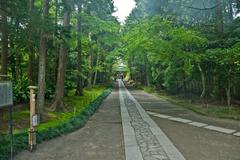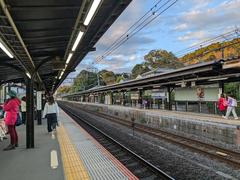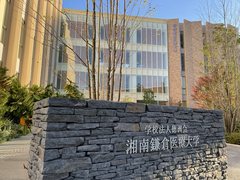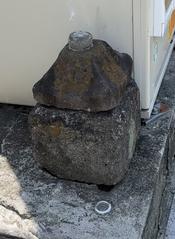
Tōkei-ji Temple Visiting Hours, Tickets & Complete Guide to Kamakura’s Historic “Divorce Temple”
Date: 04/07/2025
Introduction
Tōkei-ji (東慶寺), nestled in Kamakura’s peaceful Kita-Kamakura district, is not just a Zen Buddhist temple—it is a living testament to Japan’s history of women’s empowerment, spiritual refuge, and enduring tradition. Founded in 1285 by Lady Horiuchi (Kakusan Shidō), the widow of Hōjō Tokimune, Tōkei-ji became famous as the “Divorce Temple” (縁切寺, Enkiri-dera), where women could seek sanctuary and legal separation in feudal Japan. Today, it is cherished for its tranquil gardens, seasonal beauty, and deep cultural resonance.
This guide explores Tōkei-ji’s history, cultural legacy, visiting hours, tickets, accessibility, nearby attractions, and tips for making the most of your visit. For up-to-date details and special event information, always check official and local tourism resources (Amusing Planet; Japan National Tourism Organization; Kamakura City Official).
Table of Contents
- The Legacy of Tōkei-ji: History and Cultural Significance
- Visiting Hours, Admission, and Access
- Exploring the Temple Grounds: Main Features & Seasonal Highlights
- Special Activities and Events
- Etiquette, Accessibility, and Practical Tips
- Nearby Attractions in Kamakura
- Frequently Asked Questions (FAQ)
- References & Useful Links
- Conclusion
The Legacy of Tōkei-ji: History and Cultural Significance
Founding and Early Role
Tōkei-ji was established in 1285 by Lady Horiuchi (Kakusan Shidō) as a Zen Buddhist convent and a sanctuary for women, especially those from samurai families facing hardship. As its first abbess, Lady Horiuchi set a precedent of female leadership that shaped the temple’s identity for centuries (Amusing Planet).
“Divorce Temple” and Women’s Empowerment
During the Tokugawa period (1603–1868), Tōkei-ji became renowned as a place where women could legally obtain divorce after a period of sanctuary—often two years, later reduced to one. This was revolutionary in a time when women had almost no legal recourse in marriage. Records indicate more than 2,000 women were granted divorces here, protected from retaliation and empowered by the temple’s imperial sanction (Japan National Tourism Organization; Kamakura City Official).
Modern Era and Preservation
The temple’s unique legal authority ended in 1873, following Meiji reforms. Tōkei-ji survived natural disasters and societal change, later welcoming male leadership but retaining its heritage as a symbol of sanctuary and resilience. Today, it is a designated Historic Site, celebrated for its gardens, architecture, and role in Japanese literature and art (Kamakura City Official).
Visiting Hours, Admission, and Access
Visiting Hours
- March to October: 8:30 am – 5:00 pm (last entry 4:30 pm)
- November to February: 8:30 am – 4:00 pm (last entry 3:30 pm)
- Closed: Wednesdays and December 29 to January 3 (New Year holidays). Hours may vary for special events—check the official website (Japanese) for updates.
Admission Fees
- Adults: 200–300 yen (varies by season; check official sources)
- Children: 100 yen or free for those under 15, depending on season
- Tickets: Purchase at the temple entrance; cash only.
Access
- Location: 1367 Yamanouchi, Kamakura, Kanagawa 247-0062, Japan
- By Train: 3–5 minutes on foot from Kita-Kamakura Station (JR Yokosuka Line)
- From Tokyo: Direct trains from Tokyo or Shinagawa to Kita-Kamakura; Tōkei-ji is easily combined with Kamakura’s other major temples (Japan Experience; Japan Travel)
Exploring the Temple Grounds: Main Features & Seasonal Highlights
Layout and Atmosphere
Tōkei-ji’s grounds are a harmonious blend of mossy stone paths, seasonal gardens, and historical monuments. From the understated Sanmon gate, visitors enter a tranquil world distinct from Kamakura’s busier attractions (kamakuraguide.com).
Main Features
- Sanmon (Main Gate): Marks the transition into the temple’s peaceful sanctuary.
- Hondō (Main Hall): Houses the principal image of Shaka Nyorai; rebuilt over centuries, it retains a classic Zen aesthetic (moderntokyotimes.com).
- Bell Tower (Shōrō): Striking bronze bell used in ceremonies and meditation.
- Graveyard: Final resting place of figures such as Zen master D.T. Suzuki and Reginald Horace Blyth; a site of quiet reflection (kamakuraguide.com).
- Treasure House: Displays Buddhist artifacts, historical documents, and lacquerware crafted by nuns (Japan Travel).
- Auxiliary Structures: Includes the Kuri (monks’ quarters), Reception Hall, and a seasonal Tea House.
Seasonal Garden Highlights
- Spring: Cherry blossoms and azaleas
- Early Summer: Hydrangeas (ajisai) in full bloom
- Autumn: Brilliant red and gold maples
- Winter: Subtle beauty of plum blossoms (adventurebackpack.com)
Covered walkways and benches ensure visitors can enjoy the gardens in any weather.
Special Activities and Events
- Zazen Meditation: Sunday morning sessions; open to all levels (Tōkei-ji Official).
- Ikebana (Flower Arrangement) and Sutra Copying: Regular cultural experiences; check current schedule (Japan Travel).
- Tea Ceremony: Monthly in the Suigetsu-do tea house.
- Annual Memorial Service: Spring event honoring women who found refuge here.
- Seasonal Festivals: Especially hydrangea festival in June.
- Special Exhibitions: Occasional displays in the Treasure House.
Note: Some events require advance registration; details may change seasonally.
Etiquette, Accessibility, and Practical Tips
Etiquette
- Photography: Permitted in gardens and outdoor areas; restricted inside halls and graveyard or during ceremonies (jw-webmagazine.com).
- Shoes: Remove before entering indoor areas.
- Respectful Behavior: Maintain quiet, dress modestly, and refrain from eating or drinking within sacred spaces.
Accessibility
- Paths: Mostly flat and well-maintained, but some areas have uneven surfaces or steps.
- Wheelchair Access: Limited; contact the temple for assistance (kamakuraguide.com).
- Facilities: Restrooms and a small gift shop available near the entrance.
Practical Tips
- Bring cash for admission and small purchases.
- Visit early or on weekdays to avoid crowds, especially during hydrangea season.
- Combine your visit with nearby temples for a full Kamakura experience.
Nearby Attractions in Kamakura
- Engaku-ji: Major Zen temple adjacent to Tōkei-ji.
- Meigetsu-in: Famous for hydrangeas in June.
- Kencho-ji: Oldest Zen temple in Kamakura.
- Traditional shops and cafés: Found along the approach to Tōkei-ji (kamakurainfo.net).
Frequently Asked Questions (FAQ)
Q: What are the visiting hours?
A: March–October: 8:30 am–5:00 pm; November–February: 8:30 am–4:00 pm; closed Wednesdays and New Year holidays.
Q: How much is admission?
A: 200–300 yen for adults, 100 yen or free for children depending on season.
Q: Is the temple wheelchair accessible?
A: Limited access; main paths are flat, but some areas have steps.
Q: Can I take photos?
A: Yes, in gardens and outdoor spaces; restricted indoors and during ceremonies.
Q: Are guided tours available?
A: Occasionally through local operators; audio guides may be offered (Japan Experience).
References & Useful Links
- Tōkei-ji Temple in Kamakura: Visiting Hours, Tickets & Historical Overview, Amusing Planet
- Japan National Tourism Organization: Tōkei-ji
- Kamakura City Official Website
- Visiting Tōkei-Ji: Kamakura Guide
- Japan Travel: Tōkei-ji
- Modern Tokyo Times: Protector of Women
- Adventure Backpack: Kamakura Culture
- Kamakura Info: Tōkei-ji
- JW Web Magazine: Kamakura Guide
Conclusion
Tōkei-ji endures as a sanctuary of peace, history, and empowerment. Its beautiful gardens, storied halls, and unique legacy as a refuge for women make it an essential destination for those seeking to experience the heart of Kamakura’s spiritual and cultural landscape. Plan your journey thoughtfully, respect the temple’s traditions, and let the serenity of Tōkei-ji inspire your exploration of Japanese heritage.
For more travel tips and the latest updates on Kamakura historical sites, download the Audiala app and follow us on social media.







